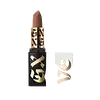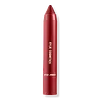What's inside
What's inside
 Key Ingredients
Key Ingredients

 Benefits
Benefits

 Concerns
Concerns

 Ingredients Side-by-side
Ingredients Side-by-side

Dimethicone
EmollientCaprylic/Capric Triglyceride
MaskingPolyethylene
AbrasiveOctyldodecanol
EmollientAluminum Hydroxide
EmollientPolysilicone-11
Polyhydroxystearic Acid
EmulsifyingSynthetic Wax
AbrasiveDisteardimonium Hectorite
StabilisingSynthetic Beeswax
Emulsion StabilisingCopernicia Cerifera Wax
Polymethylsilsesquioxane
Aroma
Pentaerythrityl Tetra-Di-T-Butyl Hydroxyhydrocinnamate
AntioxidantHdi/Trimethylol Hexyllactone Crosspolymer
Dicalcium Phosphate
AbrasiveCI 42090
Cosmetic ColorantCI 77891
Cosmetic ColorantCI 77491
Cosmetic ColorantCI 15850
Cosmetic ColorantCI 19140
Cosmetic ColorantDimethicone, Caprylic/Capric Triglyceride, Polyethylene, Octyldodecanol, Aluminum Hydroxide, Polysilicone-11, Polyhydroxystearic Acid, Synthetic Wax, Disteardimonium Hectorite, Synthetic Beeswax, Copernicia Cerifera Wax, Polymethylsilsesquioxane, Aroma, Pentaerythrityl Tetra-Di-T-Butyl Hydroxyhydrocinnamate, Hdi/Trimethylol Hexyllactone Crosspolymer, Dicalcium Phosphate, CI 42090, CI 77891, CI 77491, CI 15850, CI 19140
Isododecane
EmollientOctyldodecanol
EmollientTrimethylsiloxysilicate
EmollientCaprylyl Methicone
Skin ConditioningPolyethylene
AbrasiveSynthetic Wax
AbrasiveCeresin
Emulsion StabilisingCellulose
AbsorbentCetearyl Ethylhexanoate
EmollientCera Microcristallina
Emulsion StabilisingDisteardimonium Hectorite
StabilisingTocopherol
AntioxidantHelianthus Annuus Seed Oil
EmollientPropylene Carbonate
SolventRosmarinus Officinalis Leaf Extract
AntimicrobialSorbitan Isostearate
EmulsifyingDimethiconol
EmollientPortulaca Pilosa Extract
Skin ConditioningWater
Skin ConditioningSucrose Cocoate
EmulsifyingAlcohol
AntimicrobialPalmitoyl Tripeptide-38
Skin ConditioningCI 77891
Cosmetic ColorantIron Oxides
CI 15850
Cosmetic ColorantCI 42090
Cosmetic ColorantIsododecane, Octyldodecanol, Trimethylsiloxysilicate, Caprylyl Methicone, Polyethylene, Synthetic Wax, Ceresin, Cellulose, Cetearyl Ethylhexanoate, Cera Microcristallina, Disteardimonium Hectorite, Tocopherol, Helianthus Annuus Seed Oil, Propylene Carbonate, Rosmarinus Officinalis Leaf Extract, Sorbitan Isostearate, Dimethiconol, Portulaca Pilosa Extract, Water, Sucrose Cocoate, Alcohol, Palmitoyl Tripeptide-38, CI 77891, Iron Oxides, CI 15850, CI 42090
Ingredients Explained
These ingredients are found in both products.
Ingredients higher up in an ingredient list are typically present in a larger amount.
Ci 15850 is the pigment color red. It is an azo dye and created synthetically.
Azo dyes need to be thoroughly purified before use. This allows them to be more stable and longer-lasting.
This ingredient is common in foundations, lipsticks, and blushes. This color is described as brown/orangey red.
It has many secondary names such as Red 6 and Red 7. According to a manufacturer, Red 6 usually contains aluminum.
Learn more about CI 15850Ci 42090 is a synthetic dye created from petroleum. It is used to give a bright blue color to cosmetics, medicine, and food.
Ci 77891 is a white pigment from Titanium dioxide. It is naturally found in minerals such as rutile and ilmenite.
It's main function is to add a white color to cosmetics. It can also be mixed with other colors to create different shades.
Ci 77891 is commonly found in sunscreens due to its ability to block UV rays.
Learn more about CI 77891Disteardimonium Hectorite comes from the clay mineral named hectorite. It is used to add thickness to a product.
It can also help stabilize a product by helping to disperse other ingredients.
Hectorite is a rare, white clay mineral.
Learn more about Disteardimonium HectoriteOctyldodecanol is a fatty alcohol. It is primarily used to enhance the texture of products.
As an emulsifier, Octyldodecanol helps prevent the oils and waters from separating. It also prevents ingredients from creating foam when shaken.
Octyldodecanol is created by reducing fatty acid to an alcohol.
Due to its high molecular weight, it does not get absorbed into the skin.
Learn more about OctyldodecanolPolyethylene is a synthetic ingredient that helps the skin retain moisture. It is a polymer.
It is also typically used within product formulations to help bind solid ingredients together and thicken oil-based ingredients. When added to balms and emulsions, it helps increase the melting point temperature.
Synthetic Wax is created from fossil fuels such as natural gas. It is used to enhance texture, adjust pH, and as an occlusive.
It may also be used as an abrasive ingredient to exfoliate the skin.
Synthetic Wax may not be fungal acne safe.
Learn more about Synthetic Wax